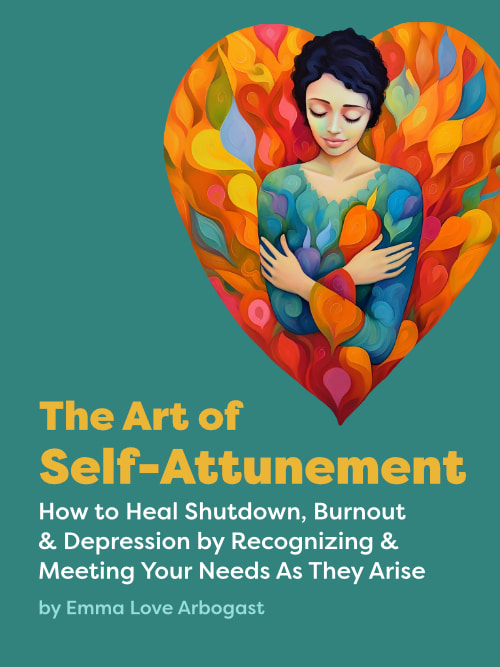How to Rewire Your Brain for Permanent Happiness with State Shifting
Have we all been lied to about the nature of happiness?
Several years ago, I figured out how to get my brain to be happy for no reason. I kept doing it because it felt great, and I knew that anything you practice becomes easier for your brain to do.
Then something unexpected happened—I would be going along, living my life, and suddenly spontaneous joy would just bubble up out of nowhere, for no reason.
After a few weeks, I stopped actively practicing because I didn’t really need to—I was already happy. Joy had become my new emotional baseline.
And so far, it seems permanent. It’s as awesome as it sounds!
But what does it mean that instead of changing my life, all I had to do was practice being happy? Maybe happiness is not what we were told it is. Maybe it’s not something “out there” that we have to earn or achieve, but rather just a state that our brain can produce at any time if we know how to activate it.
I will explain here exactly what I did, why I think it works, some things to be aware of, and address concerns people may have. If you try it and also have success with it, please leave a comment!
(And if at any point you feel overwhelmed or resistant, you might want to start with Intro to State Shifting).
What is state shifting and why do it?
State shifting is a mental technique of shifting your state of mind to a preferred state.
It is the ability to consciously choose to be happy, for no reason and unrelated to any outside circumstance (without suppressing anything or lying to yourself).
Through using a mental technique (covered below), you can self-generate joy. Then you just immerse yourself in it until it changes your state of mind.
Then, just repeat this state-shifting exercise over and over for a few weeks, and apparently it will rewire your brain so you are permanently happy. (Or at least, it did for me. I really only have a sample size of one until more people try this.)
On a technical level, practicing shifting to the state of joy will build new neural pathways and strengthen them, until it is much easier to access the state of joy than any other state, so your brain just defaults to it.
I get if you are skeptical.
I honestly think most people don’t believe me when I tell them about it, because it sounds a bit outlandish.
The idea that joy is a trainable state is a paradigm shift. It goes against all our cultural messages of what happiness is based on.
We are taught that happiness is mysterious and difficult to achieve, and either relies on external circumstances being amazing, or maybe becoming some kind of Zen monk. So, I get it.
We are so conditioned to think we have to have external things to be happy, that it often never occurs to us that maybe it’s not actually true. State shifting rejects the idea that we can only feel happy in response to external stimulus. We actually have the power to change our state to one of happiness through internal stimulus. And the more we do it, the easier it becomes—until it becomes automatic.
I think the confusion is due to a conflation of pleasure and happiness.
- Pleasure is a function of dopamine. You absolutely get diminishing returns with anything that produces pleasure. This is called Hedonic Adaptation.
- Happiness is a limbic state. It doesn’t have nearly as much to do with external events as pleasure does. It has to do with our internal wiring and emotional habits. Feeling unsafe and stressed over a long period will make you unhappy, but even then, once you get your needs met, you will return to your default level of happiness—your emotional baseline.
If you think about how the brain works, it makes sense that we can change our happiness setpoint. We have limbic templates that shape our emotional responses to events. And we can rewire these templates because neurons that fire together, wire together.
Every thought we think is either changing or reinforcing our neural pathways, but rewiring is made far faster and more effective by three things:
- mindfulness aka metacognitive awareness (this unlocks neuroplasticity)
- emotion (this gets into our limbic brain, our deepest wiring)
- repetition (this reinforces the change until it becomes spontaneous)
(Sidenote: please read the actual article above on mindfulness if you are not familiar with it as a technique. The meaning of it has been diluted recently. I’m not talking about like, “mindful eating” or whatever. It has a specific meaning of being aware of your thoughts while you are thinking them.)
Our brain often runs on autopilot, but you can reprogram that autopilot to be happier.
This doesn’t eliminate negative feelings that arise due to your real experiences and needs. Instead it will eliminate, over time, negative feelings that are purely habitual—not through trying to eliminate them, but simply through practicing joyful states so much that it changes the emotional habits of your brain itself.
This technique reprograms your default mood to be based on a state of joy, because that is what you have made easiest for your brain to access. You’ve turned that neural pathway into a superhighway by practicing it a bunch, and now it’s just easier for your brain to go down that route instead of whatever other route it used to go down.
What do I mean by “permanently happy”? How does it feel?
I mean I wake up and go through the day and feel happy most of the time.
I still feel sad when I have a reason to feel sad—but I don’t feel bad for no reason. Instead, I feel happy for no reason.
It also seems to have created some kind of buffer, where even when I feel bad, it’s not as bad.
It’s not some kind of pollyanna, toxic positivity, Stepford-wife kind of plastic happiness. It’s just feeling like I’m OK, I can’t complain. Even when I can complain, it doesn’t seem to hit as hard. Even when I’m frustrated or sad or annoyed, it’s against a backdrop of feeling basically OK.
I do a lot of work on myself, and I’ve spent a lot of time healing as well as undoing all kinds of conditioning, and this is definitely not a replacement for any of that work. It’s not changing anything but your baseline mood. But if you previously had a negative baseline mood, it’s a freaking wonderful feeling to change that.
I hope you will give this a shot, even if you are a bit skeptical that it’s possible. I swear I’m not selling anything here—I just want more people to know about it, because it really improved my life.
What exactly are states?
Your “state of mind” encompasses your thoughts, feelings, and attitudes at any given point in time. It is a broader concept than “mood” which usually just refers to emotions.
Our thoughts, worldview, and attitudes are all linked to our state of mind.
You can notice this in yourself:
- When you feel good, it’s easier to think positive thoughts. You see the world as a generally positive place. Being in a good mood doesn’t just affect your emotions—it affects how you see events, how personally you take things, and what you pay attention to.
- When you feel bad, it’s easier to notice all the things going wrong. You see the world as a generally negative place. It’s easier to remember all the bad things that have happened to you.
Your state of mind can influence your:
- emotions—your feelings and their intensity
- thoughts—beliefs, worldview, outlook, your inner dialogue
- meaning—how you interpret events
- attention—what you notice and pay attention to
- decision-making—the choices you make and the factors you consider
- behavior—actions, reactions, and interactions with others
- executive function—your ability to focus, prioritize, and accomplish tasks
- resilience—your ability to cope with challenges and setbacks
- creativity—your ability to come up with new ideas or solutions
- motivation—what you feel like doing, and if you stick with it
- memories—you will tend to recall experiences that match your state
We usually shift states unconsciously as we go through the day.
If we see a negative news story, we might suddenly feel sad. Once you are sad, it is easier to start thinking of other sad things. If we let this keep going, it will grow until it is more than just a feeling response to an event, but rather becomes a pervasive mood. Over time, this creates habitual mood states because your brain is just used to feeling this way.
Habitual feelings vs circumstantial feelings
Our brain largely operates on auto-pilot. It repetitively thinks the same thoughts, and feels the same feelings based on those thoughts. This is our what I am referring to as our background mood, default mood, or baseline emotional state.
Then, throughout our day, various feelings arise in response to what is happening in our environment, or specific things we are thinking about.
We want to keep those circumstantial emotions, as they are useful and help us navigate our needs and tend to our wellbeing.
But the background thoughts and feelings can often be stuck in a negative gear for no real reason except habit. That’s what state shifting can change.
So to review (this distinction is important!):
- Habitual feelings with no clear cause – that is what we are working to change here.
- Circumstantial feelings caused by events – we do NOT want to try to change these, because they are messages about our needs. To change these feelings, the solution is to listen to what they are telling you, and most importantly meet your needs. (Read about NVC for more on feelings as messages about needs).
The goal here is to feel the circumstantial feelings when it is appropriate, and then go back to a positive default state.
Beliefs help perpetuate states
Beliefs are thoughts we keep thinking, and we internally agree with. They are thinking habits, the way that moods are emotional habits.
Beliefs are foundational parts of how states perpetuate themselves. They fuel thoughts, that then fuel feelings. Therefore, beliefs can make states more sticky.
The technique below is not that hard to learn—the hardest part for me was actually letting go of the beliefs that we have been steeped in that we should have to “earn” happiness, and that it shouldn’t be this easy.
If you have strong beliefs like this, it will make it much harder to shift, so I suggest working on those first or at the same time. I have written more on how to do this here.
The Technique—how to do it
Training yourself to shift your state of mind at will is like gaining a superpower. Each time you deliberately shift your state, you are strengthening those neural pathways, and it becomes easier and easier to do. Then eventually your brain will spontaneously shift.
It takes a few weeks of consistent daily practice (several times a day) to wire in a new brain pathway. This is how I permanently shifted my baseline mood to consistent happiness.
How to deliberately shift your state
This is a very simple exercise. It involves bringing to mind something that makes you feel genuinely joyful and then focusing on the feeling itself, letting it fill your whole being.
- Bring to mind a happy memory, or think of a person you have genuinely joyful feelings toward—someone or something that makes you happy.
- Feel into the feeling of joy that this thought brings, and immerse yourself in it. Let it completely fill your awareness, and just sit in that feeling. You might notice yourself smile spontaneously as you review these memories.
- Once you have a solid sense of the feeling of joy, drop the memory and focus just on the feeling of joy itself.
- Continue to immerse yourself deeper into this pure feeling state.
- Only go until you feel yourself wanting to do something else. (Don’t push yourself to continue—force neutralizes joy.)
Then, practice this repetitively. That is how you build new neural pathways.
Making it a habitual state (this rewires your brain)
Over time, as your neural pathways get built up, you will be able to go directly to focusing on the feeling of joy without needing a memory. And that’s a magic feeling. You suddenly realize you can self-generate states of feeling incredibly good!
But you still need to practice more once you get to this point. I recommend doing it several times a day, for several weeks. That is what it takes to shift your baseline mood.
Here is how it progressed for me:
- I needed to use a memory to shift to joy.
- I could self-generate states of joy.
- I started spontaneously feeling joyful for no reason.
- My baseline mood permanently changed to being happier.
Remind yourself to practice in a non-demanding way.
I recommend a sticky note by your computer or on your phone that just says, “Be happy anyway?”
It’s worded as a question on purpose – think of it as an invitation, not a task. This takes any pressure off of it.
If you are not able to shift in any given moment, don’t force it. When you can shift, do it. When you can’t or you have some internal resistance to it, don’t worry about it. It will still work gradually over time. (If you feel a lot of internal resistance, it is probably due to your beliefs about happiness—I address that more here.)
Cautions and caveats
Downside? You will start to notice misery around you more.
This is the only downside I found with this process—you will start to notice how perpetually unhappy many people are, and all the reasons they have for that misery, and you will want to shake them and say, “You don’t have to feel this way!”. But I don’t recommend doing that. 😆
But seriously, “feeling bad together” is legit a bonding activity that many people are used to doing, and you won’t want to do it anymore.
It’s definitely worth it, because it feels amazing! But just be aware you will feel different than other people because you are no longer looking at happiness as this thing out there in the future or far away or something only other people have. You will know it’s just a brain state, and anyone can feel happy with the right kind of practice. It does make you feel a bit out of step with the world at large.
Will I lose my motivation?
No, this does not affect your motivation.
Misery was never good motivation anyway IMHO, but there is an idea out there that achievement = happiness, so if you are already happy, you won’t want to achieve anything. But that’s just not how the brain works.
Motivation seems to just be a different brain system than happiness (more connected to the dopamine/pleasure system), as I did not notice an effect one way or the other. If anything, your mood being boosted is better for getting things done. Depression or being in a bad mood or having a negative mindset has never been good for your productivity in general.
Don’t try to force a shift.
Genuine joy requires a sense of safety, and force of any kind is not compatible with safety. So it’s just not possible to force yourself to feel joy.
All you will end up doing is suppressing negative feelings, and be pretending to yourself that you are happy. We all know what that is like—that’s what phrases like “toxic positivity” and “spiritual bypassing” mean.
There is no force involved here. The technique I outlined above just involves directing your attention and allowing the emotions to unfold from your attention.
Do not use state shifting to avoid pain or trauma!
Do not try to shift out of painful or overwhelming feelings, simply because they are painful or overwhelming and you don’t want to experience them. That is almost guaranteed to just lead to emotional suppression or compartmentalization.
State-shifting is not a trauma healing technique. You should not use it to deal with triggers. It isn’t meant for that. In fact, what I recommend for processing trauma is turning toward the pain, not away from it.
If you are feeling desperate to feel better, you will likely be suppressing negative feelings rather than shifting states. This technique is not a substitute for doing emotional processing, trauma work, or grief work. If there are genuine reasons you feel sad or upset, you need to work with those feelings and what is causing them.
This technique is for shifting habitual negative states that aren’t related to real events. So instead of feeling bad for no reason, you now feel good for no reason. Don’t use it if you are feeling bad for a genuine reason—deal with the reason!
Let me know your experience
If you give this a shot, I would love to hear from you and learn about your experience—just leave a comment below. Right now I have a rather small sample size so I’d love to know how it works with other brains. 💚
Self-love is a set of skills you can learn

Stop Being Cruel to Yourself
$2.99


Hey there! If you're new here, welcome to the Emmaverse! 🌈✨
About me: I'm autistic/ADHD and I write about how to be free and happy from the inside out.
Keep in touch?
Self-Liberation Society

